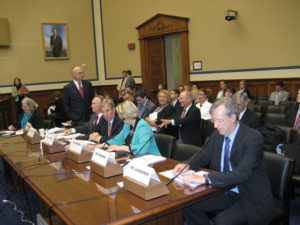Whether your company has 10 employees or 300, the knowledge and competency required to run the human resources operation can be downright overwhelming. Having the correct documentation, providing employee notices and staying compliant with ERISA can keep even the most experienced HR managers awake at night.
HR professionals know the cost of missing even one of the required employee notices, the high cost of being out of compliance with Department of Labor (DOL) requirements. The current fine is $110 per employee per day, for each day of non-compliance. If you have 20 employees and are out of compliance for 45 days, the DOL fine can cost you $99,000.
We understand your concerns. After all, there are more than 30 different COBRA notices, 20+ annual employee benefit related notices, and other compliance issues such as documentation and enrollment of flexible spending accounts. Add to that all the Obamacare reporting, which will continue to be required, and you have your basic nightmare.
What is ERISA?
ERISA is a word that strikes fear into the hearts of many small business owners. That’s because they know that non-compliance could mean large fines, yet they do not understand what exactly is required by ERISA.
There’s a lot that could be said about ERISA, but in this article, we will focus on health and welfare benefit plans.
ERISA stands for the Employee Retirement Income Security Act of 1974. It is a federal law that sets minimum standards for retirement and health benefit plans in private industry. ERISA does not require any employer to establish a benefit plan, but stipulates minimum requirements to those who do establish benefits plans.
ERISA provides that those individuals and fiduciaries who manage plans must meet certain standards of conduct. The law contains detailed provisions for reporting to the government and disclosure to participants. There are also rules aimed at assuring employees are protected and participants who qualify receive their benefits.
As long as the employer is aware of the requirements and has processes in place to assure compliance, there is no problem. This is where a good health insurance agent or HR consulting firm is important.
Simply put, an ERISA-covered health or welfare benefit plan is any plan, fund or program established or maintained by an employer or employee organization, or both, in order to provide:
- Medical, surgical or hospital care or benefits.
- Benefits in the event of sickness, accident, disability, death or unemployment.
- Vacation benefits.
- Apprenticeship or other training programs.
- Day care centers.
- Scholarship funds.
- Prepaid legal services.
- Certain other benefits described in the Labor Management Relations Act of 1947.
Key aspects of reporting and disclosure requirements governed by ERISA include:
- Summary plan descriptions to participants, employees and their covered independents including COBRA or state continuation.
- Employers with more than 100 participants must file a 5500 annually with the DOL.
- Employers with 20 or more employees must offer COBRA continuation of health coverage should a covered employee or his or her dependent no longer be eligible for coverage.
- HIPAA protects employees from discrimination based on pre-existing medical conditions or other medical conditions related to health coverage based on factors that relate to an individual’s health.
- Newborns’ and Mothers’ Health Protection Act of 1996
- Mental Health Parity Act.
- Women’s Health and Cancer Rights Act.
Letter from the DOL announcing an upcoming audit. This is the standard letter a business receives from the DOL announcing they are going to audit the company. The letter lists the 35 different documents required for your audit. As a client of Braden Benefit Strategies, if you receive this letter, we will work with you to assure points 8 through 35 are in place and meet the DOL requirements.
Does your company have a WRAP document?
If you have never heard of a WRAP document, you have a compliance issue. A WRAP document is normally explained to businesses by their agent or broker who would also provide the company with a resource for obtaining the document.
Hinkle Law has an excellent write-up about WRAP documents on their website. The piece explains, a wrap document is used to supplement already-existing documentation. More specifically, a wrap document provides the information required by ERISA by incorporating or ‘wrapping’ itself around, the insurance policy. An employee welfare benefit plan under ERISA must have a written plan document containing all the terms governing the plan. A written contract of insurance with an insurance company does not normally contain all the rules required by ERISA and is therefore not a plan document. The WRAP document and the insurance policy together comprise the complete plan document.
Read Hinkle Law’s full explanation of WRAP documents.
HR360: A Comprehensive Resource
All Braden Benefit Strategies clients are provided access to the online human resources library, HR360. Considered a blueprint to navigating the complete world of human resources, it is a unique resource that explains complicated information about a host of key benefits and related areas. HR360 simplifies the process, prevents potential employee lawsuits, and saves business owners and their staff time. The site uses a team of attorneys, human resource specialists and editors who are experts on the latest employment laws, news and the best HR practices.
We would be happy to send you a free copy of the HR360 publication, DOL Survival Guide. You can request a copy via our “Let’s Talk” link.
Patient Protection and the Affordable Care Act (ACA or “Obamacare”)

Braden Benefit Strategies is a pro-active, forward thinking agency. Our clients are notified about the latest information and changes in the healthcare industry, as they happen.
Victoria Braden, President and Chief Strategic Officer of Braden Benefit Strategies, is ACA certified through the National Association of Health Underwriters, a designation of our commitment to our clients and our level of involvement in understanding the law and its requirements of small businesses. This in-depth knowledge and commitment to seeking alternatives within the new boundaries of Obamacare has afforded Braden’s clients the latest options in creating affordable health insurance packages for their employees.

As we move to the next phase of COVID-19, new government regulations to bring businesses information and legislation requirements and determining advantages for small businesses will be critical in providing employers and employees with affordable and valued benefits. We can already predict the market will be unstable through 2021, if not longer. How we work our way through these times and challenges will affect businesses and employees alike.
Braden has a saying, “We are Americans, and we always find a legal and creative work-around.” Business owners are some of the most proactive and creative Americans.
One of these work-arounds is level-funded health insurance. All small businesses with more than 10 employees should know about this new product.
Health insurance plans can be funded in several different ways. The main options include:
- Fully-insured – ACA pricing.
- Level-funded – medically underwritten.
- Self-funded – medically underwritten.
Health insurance is a purchase designed to cover a potential risk and minimize an individual’s financial exposure.
Health insurance risk is determined by medically underwriting those individuals to be covered by the health insurance.
Health insurance premium amounts incorporate the anticipated medical and prescription drug claims, network access fees, claims administration, company management and stop-loss insurance premiums.
Fully-Insured – ACA Plans
Groups under 50 employees are not medically underwritten under the ACA and as such, insurance companies cannot determine risk. ACA requires insurance carriers to charge the same premium for the same plan, in the same geographic area.
Annual premiums in groups with 50 or more employees is based on the expected healthcare claims of the group. Employee medical questionnaires or the company’s prior healthcare claims experience is used in this calculation.
Level-Funded Health Insurance
With this funding method, employees experience health insurance coverage that looks and feels like a fully-insured policy. Employer savings is created by breaking out the components of health insurance and managing the risk (claims). Level funding is a partially self-insured health insurance policy. Employer exposure is protected at the individual employee level (specific stop-loss insurance) and overall risk/expenditure through reinsurance. Level-funded plans are named such, as once the monthly premium is established, it is constant for the coverage period (generally 12-months). The health insurance company will share or refund in total, any premium collected and not used to pay claims or expenses during the length of the contract. Refunds are generally issued at least 6-months after the end of the contract to allow processing of claims incurred the last few months of the plan.
Self-Funded Health Insurance
Large groups use this method of paying their employees’ medical expenses, allocating money equal to the expected claims and administrative costs. Claims are paid as they are incurred, generally using the services of a third-party administrator (TPA).
Historically, large companies have received partial immunity from rising medical costs by self-insuring their employee health benefits. Self-funding medical claims allows for a multiyear planning process, as virtually every component of healthcare claims and administrative expenses is spelled out. Employers are able to achieve better outcomes through more effective service, employee engagement and lower medical costs.
Employer Purchasing Coalitions
Employer purchasing coalitions pool smaller companies to create larger pools, providing smaller employers with the opportunities afforded to large corporations–namely large group pricing and sustainable health insurance benefits. Braden Benefits Strategies is experienced in creating and managing affinity programs for large franchise owners, medical groups, and independent practice associations (IPAs).




